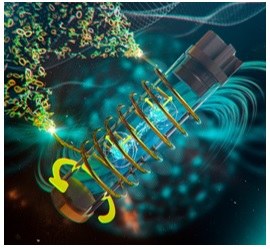Multidimensional solid-state NMR spectroscopy for the study of protein structure
Using optimal control theory, they proposed a sophisticated method (pulse sequence) that mediates the transfer of total magnetization between resonating nuclei with minimal loss. This leads to a systematic increase in sensitivity of 41% for each indirectly encoded spectral dimension. Their new 3D spectra provide a threefold increase in sensitivity, which is essential for the study of polymorphism in amyloid structures.
 picture: Tomáš Belloň
picture: Tomáš Belloň
Nuclear magnetic resonance (NMR) is an important tool in structural biology that allows us to study proteins with atomic resolution. In 2002, the Nobel Prize in Chemistry was awarded for the development of methods to determine the spatial structure of proteins in solution. However, for an important class of insoluble proteins such as amyloids and fibrils, as well as membrane proteins, solid-state NMR methods are needed. This area of research is experiencing rapid development due to improvements in hardware and experimental techniques.
In order to remove the influence of strong anisotropic interactions and thus increase the resolution between the signals of the individual nuclei, the sample is inserted into a rotor that makes an angle of 54.7° with the static magnetic field and which rotates very rapidly inside the measuring coil (so-called magic-angle-spinning, MAS). The rotation frequency can nowadays reach 160 kHz and such a rotor is one of the fastest rotating macroscopic objects made by man. Using a coil (solenoid), sophisticated radio-frequency pulses are applied to manipulate the spin states of atoms, transferring magnetization and correlating information about chemical shifts or distances between atoms. Multidimensional spectroscopy techniques with multiple transfers are used to resolve the vast overlap of responses and to extract useful information.
Zdeněk Tošner has long been involved in the application of optimal control theory to the development of solid-state NMR experiments. Optimal control is an efficient method of numerical optimization that works with several thousands of variables. Together with German colleagues, they have recently developed shaped radiofrequency pulses for magnetization transfer between nitrogen and carbon nuclei in the protein backbone. By effectively compensating for spatial inhomogeneities in the radiofrequency field of the solenoid coil, a sensitivity increase of about 50% was achieved in the respective experiments.
In the present paper, they challenge the traditional scheme of multidimensional experiments in which the spectral information is encoded into the amplitude of the measured signal. If phase encoding could be used, this would automatically lead to a further increase in the resulting sensitivity by 41% for each spectral dimension. This principle is known from NMR in solution, but has not found widespread application due to relaxation losses. In the case of solid-state NMR, the problem is that, to date, there have been no experimental techniques to transfer magnetization between heteronuclei while preserving its phase. To design such a pulse sequence, the authors have used their previously developed numerical optimization method. The result is new three-dimensional spectra that provide sensitivity that is three times higher compared to standard experiments. Such an increase in sensitivity means a ninefold reduction in measurement time and is essential for the study of polymorphisms in amyloid structures - detecting a minority form of the human lambda-III immunoglobulin light chain protein that has escaped detection so far.
In addition to this application, the work of Jan Blahut, Zdeněk Tošner and his colleagues at the Technical University of Munich also holds promise for the future. The study of proteins in the solid state has the advantage over established NMR techniques in solution that the relaxation properties do not scale with the size of the protein being studied. Thus, even large molecular systems can be measured. This, in turn, requires the use of multidimensional spectroscopy with the proposed 4- to 5-dimensional experiments, which took 33 days to measure. Full use of phase encoding would yield a 16-fold time saving - a reduction to just 2 days.
Document Actions